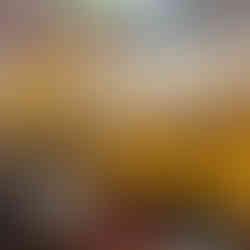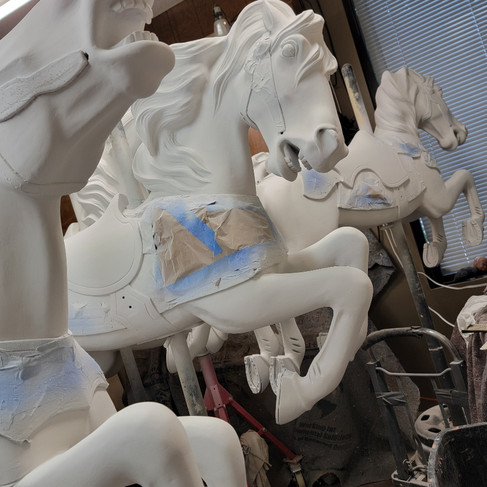Over-the-Jumps Carousel Restoration Part 1
- littlerockrepairsh
- Aug 20, 2024
- 4 min read

Photo from the LR Zoo website.
Welcome to the Little Rock Zoo’s Over-the-Jumps carousel restoration series! This year, our beloved carousel turns 100 years old—a milestone that calls for celebration and preservation. Originally designed and manufactured by the Herschell-Spillman Company in 1924 as a traveling attraction, this one-of-a-kind carousel found its forever home in Little Rock, AR, in 1942. Initially part of the Fun Park at War Memorial Stadium, the carousel was relocated to its current home at the Little Rock Zoo in 2007, where it continues to enchant visitors of all ages..
What Makes This Carousel Special?
The Over-the-Jumps carousel is more than just a ride; it’s a marvel of American engineering and a treasure of our cultural heritage. Michael Crenshaw, Founder and Lead Restorationist at Little Rock Repair Shop, shares what sets this carousel apart:
There's only four carousels left on earth that have the undulating track design. And the carousel at the Little Rock Zoo is the only one in the world that is operational. It's a wonder of American engineering.
This rare design gives riders a unique experience, simulating the sensation of galloping horses. The restoration of such a historical piece is not just about preservation but about keeping a piece of living history alive.
The Restoration Journey Begins
In 2023, the Little Rock Zoo commissioned the Little Rock Repair Shop to lead an extensive restoration project. The goal is to complete the first phase of restoration—focused on the 40 horses and 4 sleighs—by the end of 2024. Despite the ongoing work, we’ve ensured that the carousel remains operational, allowing visitors to continue enjoying this iconic attraction.
Photo from the LR Zoo website.
With nearly a million rides over its lifetime, the carousel was due for some much-needed care. Below, we offer you a glimpse into our meticulous restoration process, complete with before-and-after photos that showcase the transformation.
Cleaning: Preparing for Restoration
The first step in our restoration process is a thorough cleaning of each horse. Years of exposure to the elements, pollution, and constant use have taken their toll. Michael Crenshaw explains the challenges:
You've got pollution damage from traffic and humans, elemental damage from nature, and sound damage from the freeway and roads which causes damage from constant vibration . That's one of those often overlooked elements of damage to antiques and especially historic homes and structures.
Take a look at these close-ups of the horses before restoration began. The grime, wear, and tear are evident, but so is the intricate craftsmanship that we’re committed to preserving.
Preparing for Restoration: Unveiling the Original Beauty
After cleaning, we move on to removing the varnish to inspect the condition of the underlying paint. Most of the horses require sanding to remove damaged areas. We also remove all metal hardware, which is cleaned and repaired separately. Protective tape is carefully applied to the horses' eyes and jewels, ensuring they remain unharmed during the restoration. For horses with wood damage, we take special care to restore their hand-carved details to their original beauty.
It becomes a cleansing process for the operator as well as the object that's being operated on, you know, it just cleanses you from the inside out like a spiritual process.
Here’s a look at the results from the first stage of the restoration process.

Some areas of the horses, such as the yellow and gold blankets, are in good enough condition to be preserved with minimal touch-ups. These sections are carefully taped off before we move on to the next stage.
Check out our team in action as they prepare three horses in the paint studio.
Priming: Setting the Stage for Color
Once the horses are cleaned, sanded, and taped, they’re ready for priming. We use an oil-based primer to create a smooth base for the intricate painting process. Each horse receives two coats of primer, ensuring durability and a flawless finish. Here’s Michael Crenshaw applying the first coat. The majority of preparation and pairing is done my hand. This is the only step in the restoration process when we use a machine.
Michael shares:
At this point, when there's no color on whatsoever, you can see every line and every contour, the imperfections and the perfections. All of these lines - this eyebrow line and this line of this cheekbone right here the line that curls around lip - just amazing that somebody with their hand, a chisel, and a hammer making everything look realistic The details in the carving are through the roof!
With the second coat applied, the horses are ready for the final stage—bringing them back to life with vibrant color.
Stay Tuned for More!
This is just the beginning of our restoration journey. In the next part of our blog series, we’ll dive into the magical process of painting and finishing the carousel horses. Stay tuned to see these beautiful creations come to life once again!
Have you ever ridden the Over-the-Jumps carousel? Share your memories with us in the comments below. Don’t forget to visit the Little Rock Zoo to see the carousel in action and witness the restoration progress firsthand!
If you’d like to follow the restoration journey closely, subscribe to our newsletter and be the first to know about new updates and behind-the-scenes stories.
Join us on the Little Rock Zoo on Tuesday, September 10 at 6:30 PM for a special after-hours event and celebration. Learn more here.
All photos and videos from the Little Rock Repair Shop (C) 2024.


























BEAUTIFUL!!!!!! Thank you for restoring this one-of-a-kind beauty!